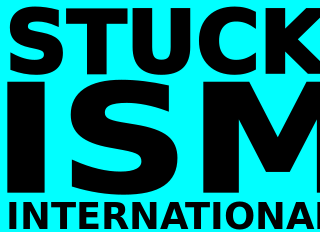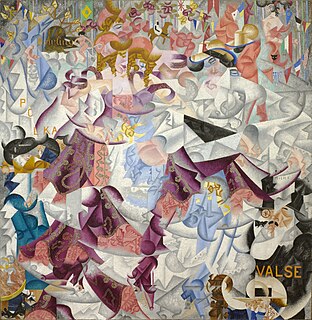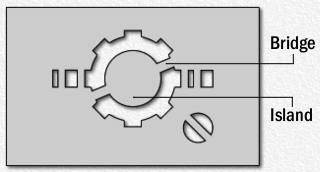Related Research Articles

Dada or Dadaism was an art movement of the European avant-garde in the early 20th century, with early centres in Zürich, Switzerland, at the Cabaret Voltaire. New York Dada began c. 1915, and after 1920 Dada flourished in Paris. Dadaist activities lasted until c. the mid 1920s.

André Robert Breton was a French writer and poet. He is known best as the co-founder, leader, and principal theorist of surrealism. His writings include the first Surrealist Manifesto of 1924, in which he defined surrealism as "pure psychic automatism".
The Situationist International (SI) was an international organization of social revolutionaries made up of avant-garde artists, intellectuals, and political theorists. It was prominent in Europe from its formation in 1957 to its dissolution in 1972. The intellectual foundations of the Situationist International were derived primarily from libertarian Marxism and the avant-garde art movements of the early 20th century, particularly Dada and Surrealism. Overall, situationist theory represented an attempt to synthesize this diverse field of theoretical disciplines into a modern and comprehensive critique of mid-20th century advanced capitalism.

Stuckism is an international art movement founded in 1999 by Billy Childish and Charles Thomson to promote figurative painting as opposed to conceptual art. By May 2017 the initial group of 13 British artists had expanded to 236 groups in 52 countries.

Vorticism was a London-based modernist art movement formed in 1914 by the writer and artist Wyndham Lewis. The movement was partially inspired by Cubism and was introduced to the public by means of the publication of the Vorticist manifesto in Blast magazine. Familiar forms of representational art were rejected in favour of a geometric style that tended towards a hard-edged abstraction. Lewis proved unable to harness the talents of his disparate group of avant-garde artists; however, for a brief period Vorticism proved to be an exciting intervention and an artistic riposte to Marinetti’s Futurism and the post-impressionism of Roger Fry’s Omega Workshops.

Futurism was an artistic and social movement that originated in Italy in the early 20th century which later also developed in Russia. It emphasized dynamism, speed, technology, youth, violence, and objects such as the car, the airplane, and the industrial city. Its key figures were the Italians Filippo Tommaso Marinetti, Umberto Boccioni, Carlo Carrà, Fortunato Depero, Gino Severini, Giacomo Balla, and Luigi Russolo. It glorified modernity and aimed to liberate Italy from the weight of its past. Important Futurist works included Marinetti's Manifesto of Futurism, Boccioni's sculpture Unique Forms of Continuity in Space, Balla's painting Abstract Speed + Sound, and Russolo's The Art of Noises.

Stencilling produces an image or pattern by applying pigment to a surface under an intermediate object with designed gaps in it which create the pattern or image by only allowing the pigment to reach some parts of the surface. The stencil is both the resulting image or pattern and the intermediate object; the context in which stencil is used makes clear which meaning is intended. In practice, the (object) stencil is usually a thin sheet of material, such as paper, plastic, wood or metal, with letters or a design cut from it, used to produce the letters or design on an underlying surface by applying pigment through the cut-out holes in the material.
Helmut Sturm was a German painter.
Walter Olmo was an Italian musician and composer. In 1957 he wrote Towards a Conception of Musical Experimentation. He advocated avant-garde electronic and contemporary music. In his 1975 he published the essay La fine della preistoria musicale.

Zang Tumb Tumb is a sound poem and concrete poem written by Filippo Tommaso Marinetti, an Italian futurist. It appeared in excerpts in journals between 1912 and 1914, when it was published as an artist's book in Milan. It is an account of the Battle of Adrianople, which he witnessed as a reporter for L'Intransigeant. The poem uses Parole in libertà and other poetic impressions of the events of the battle, including the sounds of gunfire and explosions. The work is now seen as a seminal work of modernist art, and an enormous influence on the emerging culture of European avant-garde print.
"[The] masterpiece of Words-in-freedom and of Marinetti’s literary career was the novel Zang Tumb Tuuum... the story of the siege by the Bulgarians of Turkish Adrianople in the Balkan War, which Marinetti had witnessed as a war reporter. The dynamic rhythms and onomatopoetic possibilities that the new form offered were made even more effective through the revolutionary use of different typefaces, forms and graphic arrangements and sizes that became a distinctive part of Futurism. In Zang Tumb Tuuum; they are used to express an extraordinary range of different moods and speeds, quite apart from the noise and chaos of battle.... Audiences in London, Berlin and Rome alike were bowled over by the tongue-twisting vitality with which Marinetti declaimed Zang Tumb Tuuum. As an extended sound poem it stands as one of the monuments of experimental literature, its telegraphic barrage of nouns, colours, exclamations and directions pouring out in the screeching of trains, the rat-a-tat-tat of gunfire, and the clatter of telegraphic messages" Caroline Tisdall and Angelo Bozzola
Anti-art is a loosely used term applied to an array of concepts and attitudes that reject prior definitions of art and question art in general. Somewhat paradoxically, anti-art tends to conduct this questioning and rejection from the vantage point of art. The term is associated with the Dada movement and is generally accepted as attributable to Marcel Duchamp pre-World War I around 1914, when he began to use found objects as art. It was used to describe revolutionary forms of art. The term was used later by the Conceptual artists of the 1960s to describe the work of those who claimed to have retired altogether from the practice of art, from the production of works which could be sold.

José Sobral de Almada Negreiros was a Portuguese artist. He was born in the colony of Portuguese São Tomé and Príncipe, the son of a Portuguese father, António Lobo de Almada Negreiros, and a Santomean mother, Elvira Freire Sobral. Besides literature and painting, Almada developed ballet choreographies, and worked on tapestry, engraving, murals, caricature, mosaic, azulejo and stained glass.

Giuseppe Pinot-Gallizio (1902–1964) was an Italian painter, the formulator of industrial painting, and a founding member of the Situationist International. He was also a scholar of popular culture, archaeology, nomadism, and botany.

An art manifesto is a public declaration of the intentions, motives, or views of an artist or artistic movement. Manifestos are a standard feature of the various movements in the modernist avant-garde and are still written today. Art manifestos are sometimes in their rhetoric intended for shock value, to achieve a revolutionary effect. They often address wider issues, such as the political system. Typical themes are the need for revolution, freedom and the implied or overtly stated superiority of the writers over the status quo. The manifesto gives a means of expressing, publicising and recording ideas for the artist or art group—even if only one or two people write the words, it is mostly still attributed to the group name.
McKenzie Wark is an Australian-born writer and scholar. Wark is known for her writings on media theory, critical theory, new media, and the Situationist International. Her best known works are A Hacker Manifesto and Gamer Theory. She is Professor of Media and Cultural Studies at The New School in New York City.

Soshana Afroyim was an Austrian painter of the Modernism period. Soshana was a full-time artist and traveled frequently, exhibiting her work internationally. During her journeys, she portrayed many well known personalities and her art developed in different directions. Her early period artwork was largely naturalistic in nature, showing landscapes and portraits. Later her style developed towards abstract art, strongly influenced by Asian calligraphy.

Fillìa was the name adopted by Luigi Colombo, an Italian artist associated with the second generation of Futurism. Aside from painting, his works included interior design, architecture, furniture and decorative objects.
Report on the Construction of Situations is the founding Manifesto of the Situationist International revolutionary organization. The pamphlet was published by Guy Debord in June 1957, and the following month the organization was founded, at Cosio d'Arroscia, Italy.
The International Movement for an Imaginist Bauhaus was a small European avant-garde artistic tendency that arose out of the breakup of COBRA, and was initiated by contact between former COBRA members Asger Jorn and Enrico Baj and Sergio Dangelo of the Nuclear Art Movement.

Industrial Society and Its Future, widely called the Unabomber Manifesto, is a 35,000 word essay by Ted Kaczynski contending that the Industrial Revolution began a harmful process of technology destroying nature, while forcing humans to adapt to machines, and creating a sociopolitical order that suppresses human freedom and potential. The manifesto formed the ideological foundation of Kaczynski's 1978–1995 mail bomb campaign, designed to protect wilderness by hastening the collapse of industrial society.